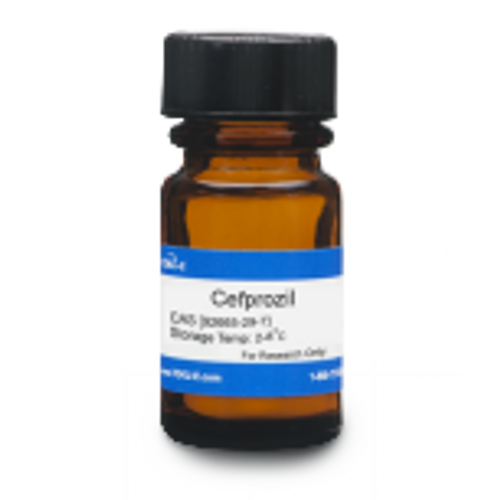Cefprozil is a semisynthetic, second-generation cephalosporin beta-lactam antibiotic with bactericidal activity. Cefprozil is soluble in DMSO (10 mg/ml). It is sparingly soluble in water.
| Mechanism of Action | Like β-lactams, cephalosporins interfere with PBP (penicillin binding protein) activity involved in the final phase of peptidoglycan synthesis. PBP’s are enzymes which catalyze a pentaglycine crosslink between alanine and lysine residues providing additional strength to the cell wall. Without a pentaglycine crosslink, the integrity of the cell wall is severely compromised and ultimately leads to cell lysis and death. Resistance to cephalosporins is commonly due to cells containing plasmid encoded β-lactamases. |
| Spectrum | Cefprozil is a broad-spectrum antibiotic targeting Gram-negative and Gram-positive bacteria such as those causing ear, nose, throat, and skin infections. |
| Microbiology Applications | Cefprozil is commonly used in clinical in vitro microbiological antimicrobial susceptibility tests (panels, discs, and MIC strips) against Gram-positive and Gram-negative microbial isolates. Medical microbiologists use AST results to recommend antibiotic treatment options. Representative MIC values include:
|
| Cancer Applications | When cells become malignant, they often lose their primary cilium, a microtubule-based sensory organelle. Thus, the potential to restore the cilium is being investigated as a therapeutic approach to attenuate tumor growth in cancer research. Commonly used chemotherapeutic drugs like Cefprozil can restore ciliogenesis, and thus they are referred to as ciliogenic drugs. Using pancreatic cancer cell lines CFPAC-1 and PANC-1, researchers found a causative link between secreted ATP and cilia induction via an autocrine/paracrine loop involving extracellular ATP-purinergic receptor signaling pathway (Khan et al, 2017). |
| Molecular Formula | C18H19N3O5S |
| Solubility | Soluble in DMSO (10 mg/ml). Sparingly soluble in water (0.055 mg/ml). |
| References | Barriere SL (1992) Pharmacology and pharmacokinetics of Cefprozil, Clin. Infect. Dis. 14 (2): S184–S188 Khan, N et al (2017) Drug-induced ciliogenesis in pancreatic cancer cells is facilitated by the secreted ATP-purinergic receptor signaling pathway. Oncotarget 9 (3):3507-3518 PMID 29423062 Naito T et al (1987) Synthesis and structure-activity relationships of a new oral cephalosporin, BMY-28100 and related compounds. J Antibiot (Tokyo) 40(7):991-1005. PMID 3624077 |
| MIC | Bacteroides bivius| 8 - 16|| Bacteroides disiens| 8 - 16|| Bacteroides distasonis| 8 - 16|| Bacteroides fragilis| 8 - 16|| Bacteroides ovatus| 8 - 16|| Bacteroides thetaiotaomicron| 8 - 16|| Bacteroides vulgatus| 8 - 16|| Brucella abortus| 0.13 - 8|| Brucella melitensis| 13 - 8|| Brucella suis| 0.13 - 8|| Citrobacter freundii| 8 - >64|| Clostridium difficile| 64 - >64|| Clostridium histolyticum | 1 - 16|| Clostridium sordellii| 1 - 16|| Clostridium sporogenes| 1 - 16|| Enterobacter aerogenes| 16 - >64|| Enterobacter cloacae| 8 - >64|| Enterobacter sakazakii| 1 - 8|| Enterococcus faecalis| 8 - ?|| Enterococcus faecium| 4 - 16|| Enterococcus liquefaciens | 4 - 16|| Escherichia coli | 0.5 - 16|| Haemophilus influenzae| <0.12 - 32|| Haemophilus parainfluenzae| 0.5 - 4|| Haemophilus spp.| 41380|| Hafnia alvei| 8 - 32|| Helicobacter pylori| 0.25 - 8|| Klebsiella oxytoca| 0.5 - 16|| Klebsiella pneumoniae| 0.5 - 64|| Listeria innocua| 1 - 8|| Listeria ivanovii| 1 - 8|| Listeria monocytogenes| 1 - 8|| Listeria seeligeri| 1 - 8|| Listeria welshimeri| 1 - 8|| Moraxella catarrhalis| ≤0.12 - 8|| Morganella morganii| 32 - >64|| Neisseria gonorrhoeae| 1 - >32|| Proteus mirabilis| 4 - 16|| Proteus vulgaris| ≥64|| Providencia rettgeri| 2 - >64|| Providencia stuartii| 4 - >64|| Pseudomonas aeruginosa| >64|| Pseudomonas cepacia| >64|| Pseudomonas fluorescens | >64|| Pseudomonas putida| >64|| Pseudomonas stutzeri| >64|| Salmonella Agona| 0.25 - 1|| Salmonella Brandenburg| 0.25 - 1|| Salmonella Enteritidis| 0.25 - 1|| Salmonella typhimurium| 0.25 - 1|| Serratia liquefaciens| ≥64|| Serratia marcescens| ≥64|| Shigella boydii| 2 - 8|| Shigella flexneri| 2 - 8|| Shigella sonnei| 2 - 8|| Staphylococcus aureus| 0.25 - 32|| Staphylococcus cohnii| 0.25 - 2|| Staphylococcus epidermidis| 0.5 - 64|| Staphylococcus haemolyticus| 0.5 - >64|| Staphylococcus hominis| 0.25 - 2|| Staphylococcus saprophyticus| 0.5 - 1|| Staphylococcus simulans| 0.25 - 1|| Staphylococcus warneri| 0.5 - 2|| Streptococci| 0.015 - 0.13|| Streptococcus milleri (group)| 0.13 - 25|| Streptococcus mitior| 0.13 - 2|| Streptococcus pneumonia| 0.03 - 64|| Xanthomonas maltophilia| >64|| Yersinia enterocolitica| 16 - 32|| |



